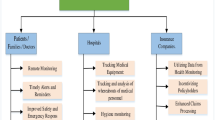Abstract
Patient medication safety is an important issue in patient medication systems. In order to prevent medication errors, integrating Radio Frequency Identification (RFID) technology into automated patient medication systems is required in hospitals. Based on RFID technology, such systems can provide medical evidence for patients’ prescriptions and medicine doses, etc. Due to the mutual authentication between the medication server and the tag, RFID authentication scheme is the best choice for automated patient medication systems. In this paper, we present a RFID mutual authentication scheme based on elliptic curve cryptography (ECC) to enhance patient medication safety. Our scheme can achieve security requirements and overcome various attacks existing in other schemes. In addition, our scheme has better performance in terms of computational cost and communication overhead. Therefore, the proposed scheme is well suitable for patient medication systems.

Similar content being viewed by others
References
Annual report. Technical report, London School of Hygiene and Tropical Medicine report, 2012
National Coordinating Council for Medication Error Reporting and Prevention, Recommendations to Enhance Accuracy of Administration of Medications. Retrieved from http://www.nccmerp.org/council/council1999-06-29.html
Juels, A., Yoking-proofs for RFID tags. In: First International Workshop on Pervasive Computing and Communication Security, 2004
Sandlin, D., SurgiChip-new technology for prevention of wrong site, wrong procedure, wrong person surgery. J. Perianesth. Nurs. 20:2144–2146, 2005.
Wu, F., Kuo
Sun, P.R., Wang, B.H., Wu, F., A new method to guard inpatient medication safety by the implementation of RFID. J. Med. Syst. 32:4327–4332, 2008.
Huang, H.H., and Ku, C.Y., A rfid grouping proof protocol for medication safety of inpatient. J. Med. Syst. 33(6):467–474, 2009.
Lo, N.-W., and Yeh, K.-H., Anonymous coexistence proofs for RFID tags. J. Inf. Sci. Eng. 26(4):1213–1230, 2010.
Yen, Y.C., Lo, N.W., Wu, T.C., Two rfid-based solutions for secure inpatient medication administration. J. Med. Syst. 36(5):2769–2778, 2012.
Li, N., Mu, Y., Susilo, W., Guo, F., Varadharajan, V., Privacy-Preserving Authorized RFID Authentication Protocols, Radio Frequency Identification: Security and Privacy Issues, pp. 108–122: Springer International Publishing, 2014.
Chen, Y., Chou, J.-S., Sun, H.-M., A novel mutual authentication scheme based on quadratic residues for RFID systems. Computer Networks 52:2373–2380, 2008.
Cao, T., and Shen, P., Cryptanalysis of some RFID authentication protocols. J. of Commu. 3(7):20–27, 2008.
Yeh, T.-C., Wu, C.-H., Tseng, Y.-M., Improvement of the RFID authentication scheme based on quadratic residues. Computer Communications 34:337–341, 2011.
Doss, R., Sundaresan, S., Zhou, W., A practical quadratic residues based scheme for authentication and privacy in mobile RFID systems. Ad Hoc Networks 11(1):383–396, 2013.
Tuyls, P., and Batina, L.: RFID-tags for Anti-Counterfeiting. Topics in cryptology-CT-RSA 2006, 115-131 (2006)
Batina, L., Guajardo, J., Kerins, T., Mentens, N., Tuyls, P., Verbauwhede, I.: Public-key cryptography for RFID-tags. Fifth annual IEEE international conference on PerCom workshops’ 07, pp. 217–222. IEEE (2007)
Lee, Y., Batina, L., Verbauwhede, I.: EC-RAC (ECDLP based randomized access control): provably secure RFID authentication protocol. 2008 I.E. international conference on RFID, pp. 97–104. IEEE (2008)
Bringer, J., Chabanne, H., Icart, T.: Cryptanalysis of EC-RAC, a RFID identification protocol. International Conference on Cryptology and Network Security-CANS’08, Lecture Notes in Computer Science. Springer-Verlag (2008)
Chou, J.-S., A secure RFID authentication protocol to enhance patient medication safety using elliptic curve cryptography. J. Supercomput., 2014. doi:10.1007/s11227-013-1073-x.
Zhang, Z. Z., and Qi, Q. Q., An Efficient RFID Authentication Protocol to Enhance Patient Medication Safety Using Elliptic Curve Cryptography. J. Med. Syst. 38(5):1–7, 2014.
Liao, Y., and Hsiao, C., A secure ECC-based RFID authentication scheme integrated with ID-verifier transfer protocol. Ad Hoc Networks 18:133–146, 2014.
Peeters, R., and Hermans, J., Attack on Liao and Hsiao’s Secure ECC-based RFID Authentication Scheme integrated with ID-Verifier Transfer Protocol. Cryptology ePrint Archive, Report 2013/399, 2013
Zhao, Z.g., A Secure RFID Authentication Protocol for Healthcare Environments Using Elliptic Curve Cryptosystem. J. Med. Syst. 38(5):1–7, 2014.
He, D., Kumar, N., Chilamkurti, N., Lee, J.-H., Lightweight ECC based RFID authentication integrated with an ID verifier transfer protocol. J. Med. Syst. 38(10):1–6, 2014.
He, D., Kumar, N., Khan, M.K., Robustanonymous authentication protocol for healthcare applications using wirelessmedical sensor networks. Multimedia Systems 21(1):49–60, 2013.
Guo, P., Wang, J., Li, B., Lee, S., A Variable Threshold-value Authentication Architecture for Wireless Mesh Networks. Journal of Internet Technology 15(6):929–936, 2014.
Ren, Y., Shen, J., Wang, J., Han, J., Lee, S., Mutual Verifiable Provable Data Auditing in Public Cloud Storage. Journal of Internet Technology 16(2):317–323, 2015.
Shen, J., Tan, H., Wang, J., Wang, J., Lee, S., A Novel Routing Protocol Providing Good Transmission Reliability in Underwater Sensor Networks. Journal of Internet Technology 16(1):171–178, 2015.
Han, W., and Zhu, Z., An ID-based mutual authentication with key agreement protocol for multiserver environment on elliptic curve cryptosystem. Int. J. Commun. Syst. 27(8):1173–1185, 2014.
He, D., Kumar, N., Chilamkurti, N., A secure temporal-credential-based mutual authentication and key agreement scheme with pseudo identity for wireless sensor networks. Information Sciences, 2015. doi:10.1016/j.ins.2015.02.010.
He, D., and Zeadally, S., Authentication protocol for ambient assisted living system. IEEE Communications Magazine 35(1):71–77, 2015.
He, D., Kumar, N., Chen, J., et al., Robust anonymous authentication protocol for healthcare applications using wireless medical sensor networks. Multimedia Systems 21(1):49–60, 2015.
Hao, X., Wang, J., Yang, Q., Yan, X., and Li, P., A chaotic map-based authentication scheme for telecare medicine information systems. doi:10.1007/s10916-012-9919-y, 2013
He, D., and Wang, D., Robust biometrics-based authentication scheme for multi-server environment. IEEE Systems Journal,1–8, 2014.
He, D., Zhang, Y., Chen, J., Cryptanalysis and improvement of an anonymous authentication protocol for wireless access networks. Wireless Personal Communications 74(2):229–243, 2014.
Acknowledgments
This work is supported by the National Natural Science Foundation of China (Grant Nos.61272525, 61370203 and 61462048).
Author information
Authors and Affiliations
Corresponding author
Additional information
This article is part of the Topical Collection on Systems-Level Quality Improvement
Rights and permissions
About this article
Cite this article
Jin, C., Xu, C., Zhang, X. et al. A Secure ECC-based RFID Mutual Authentication Protocol to Enhance Patient Medication Safety. J Med Syst 40, 12 (2016). https://doi.org/10.1007/s10916-015-0362-8
Received:
Accepted:
Published:
DOI: https://doi.org/10.1007/s10916-015-0362-8




